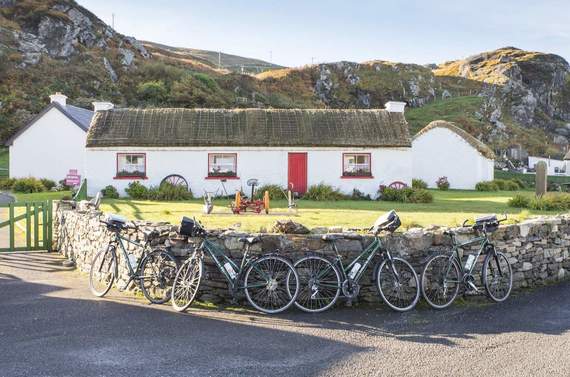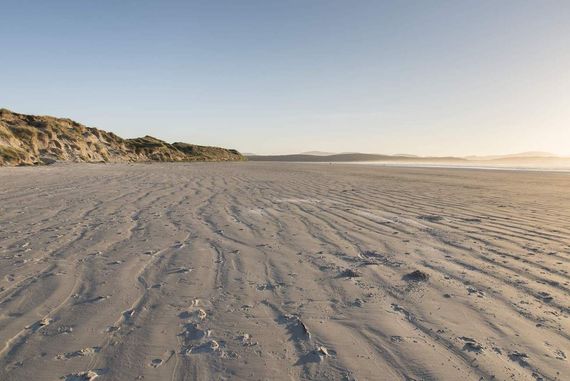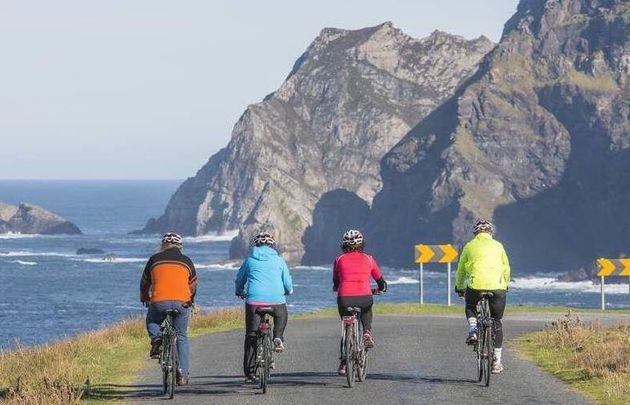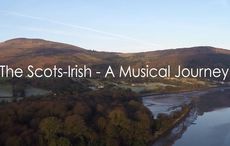Unlike many of the boundless territories of west Donegal, Glencolmcille is a distinct locus, a place of clear, knowable boundaries, locked in by the Atlantic to the west, and by a wall of bog-blanketed mountains to the north, east and south. It may have been this aspect of the glen that attracted man since earliest times: it has been inhabited for at least 6,000 years.
A rich collection of monuments from the Neolithic period through the Iron Age and the early Christian period to the time of the Napoleonic Wars can be found in the landscape, preserved by the remoteness of the place, the poverty of the people in recent centuries, and religious devotion.
The land along the western seaboard of Donegal is sub-standard, and the survival of the people and culture seems to be due mainly to fishing and long-forged economic links with Scotland, where seasonal work has long augmented meager incomes. By the end of the 1940s, however, emigration from places like Glencolmcille began to become more than seasonal and threatened to destroy the already impoverished community.
In 1951, however, things began to change in the glen when new parish priest, Father James McDyer, arrived on his bike. McDyer (1910-87) had worked as a curate to the Irish in Southwark, where he experienced the full horror of the Blitz. After the war, before coming to the glen, he was parish priest of Tory Island, where American author Dorothy Harrison Therman, in her book Stories from Tory Island, described him as a man who seemed to possess exceptional powers.
He was shocked by what he found in Glencolmcille: in his own words, he was ‘as mad as hell’ that the people had been subjected to such neglect: there was no electricity, no piped water, and no assistance towards industry or economic structure in the area.
“I’m an activist by nature,” he later said, “and I felt it was no damn good preaching justice and equality of a Sunday if you cannot work to ensure it happens on Monday.” Within a month of arriving, he had formed a Parish Council, in which man and women were represented on a fifty-fifty basis. The first task he set was to build a community hall, which he saw as an essential starting point to bringing people together. The urgency he brought to the project is evidenced by the hall being completed within ten weeks by enthusiastic local labor with mainly donated materials.

Glencolumbkille Folk Village.
Father McDyer was instrumental in getting electricity and a water supply, and made valiant attempts to establish a communal farm. He was interested in the notion of ‘Christian Communism with a little Capitalism thrown in’, and saw himself ‘traveling along the road towards radical socialism’. His revolutionary message, however, was regarded by government officials as being too radical, and he was thought to be experimenting with communism.
He did succeed in developing tourism and setting up small community-based industries, such as weaving and knitting, but his main achievement was the transformation of the Glen through radically improved living conditions, and firmly establishing the community on a road to fulfillment.

Love Irish history? Share your favorite stories with other history buffs in the IrishCentral History Facebook group.
Although there is no documentary evidence, local tradition suggests that St Colmcille lived for a while in the glen. For many centuries a turas, or pilgrimage route dedicated to Colmcille, touching on fifteen ancient stations, has circled the glen. The stations are ancient stone slabs with incised crosses, stone cairns or, in one case, the remains of a building said to be St Colmcille’s chapel. Between each station, pilgrims recite prescribed prayers, and circle each station a prescribed number of times. One of the cross-slabs has a hole through it, and it is said that pilgrims without sin can peer through the hole and see the kingdom of heaven. The annual St Colmcille turas takes place on 9 June, but up until the 1950s locals used to walk it every Sunday. Our host, Máiread, told me that it is mainly the visitors who want to do it today.

Dooey Beach, in Glencolmcille, County Donegal.
We set out on the turas one evening, starting just outside the wall of the Church of Ireland church, picturesquely sited in the middle of the valley. Maybe the powers-that-be somehow sensed that we hadn’t renounced ‘the World, the Flesh and the Devil’, nor said the required fifteen decades of the rosary, and we got only as far as station three when a rising tide swiftly and almost magically flooded the road ahead of us and we had to give up. It was probably just as well because we were told later that when the tide is high, one might have to wade for 1.2 kilometers of marsh, between stations eight and nine.
Glencolmcille is a Gaeltacht area, that is, a government-recognized region where Gaelic is the everyday language. There are Gaeltachts in Mayo, Galway, Kerry, Cork, Meath, and Waterford, and about 100,000 people live in them. A state agency called Údarás na Gaeltachta promotes and administers the development of the Gaeltacht regions, and can provide employment grants, capital grants, rent subsidies, interest subsidies and training grants to assist new and established businesses.
The Gaeltacht in Glencolmcille provides Gaelic language courses for adults, and summer schools had just finished the week before we arrived. Apart from learning the language, adult students can also attend classes in archaeology or flute and tin-whistle playing, and I was told that the craic is great! Apart from hearing Mairead speaking Gaelic on the phone, we heard only English spoken in the pub and in the shops.
After abandoning the turas, we made our way towards one of the stations not affected by flooding. I approached a chatting trio of local farmers to ask permission to cross a field, and opened by politely saying, ‘gabh mo leithscéal’, or ‘excuse me’. The three chuckled together, and one of them asked me in English was I attending one of the Irish courses. I said I wasn’t, but was following the turas. They said there was no problem crossing the field, and Teresa and I continued on our way, leaving the men still chuckling. When I related this to Mairead, she smiled.
‘The term ‘gabh mo leithscéal’ is not commonly used in Donegal,’ she said. ‘It’s more an east coast thing. The locals, however, hear it so much from the students who come here that they have named them the ‘gabhmoleithscéals!’
There are ten major megalithic tombs within and in the immediate vicinity of Glencolmcille, an unusual density of such monuments, and they include, in the Farranmacbride townland, the largest court tomb in Ireland. Court tombs are Neolithic tombs built from large slabs of stone and set in a circular or oval ‘entrance’ courtyard surrounded by a stone wall. We wandered down a narrow, winding road bordered by fuchsia, heather and glowing garlands of montbretia to find the Farranmacbride tomb. A tiny wooden gate led us to a path that bridged a tinkling stream, and we crossed field to reach the fenced-off monument, scattering rabbits with their white tails bobbing.
The tomb looked like something as ancient as the earth itself had pushed up through the grass and bog, seeking light. Although it had lost lots of its smaller stones over the years to field walls, it was very extensive, and it must have taken many to build it. The enclosure was overgrown with grass and wildflowers camouflaging ankle-twisting holes between stones, and I was a while figuring out the layout. The tomb itself was covered with great roof slabs painted thickly with map lichen, but gaps provided glimpses of the dark, box-like interior.
I tried to conjure up what it looked like when it was built, and to imagine our ancestors gathering in the court for a burial ceremony. The construction was evidence that five or six millennia ago Glencolmcille was a very different place, an extensive mountain oasis of lush fertile fields, full of crops and livestock, providing for a large healthy population.
Our helpful host, Mairead, arranged for me to visit another monument, a souterrain, in the grounds of the church. Souterrains are underground chambers buiIt for refuge or food storage, dating from the Iron Age, normally found along Europe’s Atlantic fringe in places like western France, Cornwall, and Ireland. Some are quite complex, with side galleries, chambers, stepped floors, and concealed exits. Irish souterrains seem to date from the early Christian period, and are often associated with settlements such as ring fort farmsteads; it seems likely they were used as hiding places for concealing people and goods during violent times. Paddy Beg Gillespie, the holder of the keys for this souterrain, came to open it up for us. A rotund, smiling man, he was a local celebrity, having appeared, showing off the souterrain, on a number of television shows.
He opened a timber hatch revealing a circular, stone-lined ‘manhole’. A rather rickety ladder led down into the dark. Paddy didn’t come down the ladder with me because of his arthritis; he stayed topside chatting with Teresa about the fact that he has been waiting three years to have the operation. With painful arthritis, I don’t know how the man was so cheerful, but he was, and he made sure I knew all the facts about the souterrain, particularly that it had been carbon-dated to the eighth century.
The floor was about three meters below ground level, and I enjoyed the experience of standing in the dark entry chamber a little while, letting the ambiance of this strange place flow over me before I turned on my torch. The walls were of dry stone, supporting a roof of great stone slabs, and the floor was earthen. There was at least one cupboard-like niche in one of the walls. Off the entry chamber, in which there was barely standing room, I could see that there were two passages, one quite wide, and the other narrow. They seemed to extend a good five meters either way. I didn’t clamber into them; it was enough to see the extent of this remarkable construction and to realize that it was the oldest unaltered, unadded to, unrestored, and complete man-made structure I had ever been in. While Paddy Beg chatted with Teresa up above, I had a foot in the ‘other world’ and I spent a little while taking a flight of imagination back in time fourteen hundred years.
* "Europe's Atlantic Fringe: Exploring the west coasts of Portugal, Spain, and Ireland" by Michael Fewer is published by Ashfield Press and is available from www.books.ie.
** Originally published in Ireland of the Welcomes Magazine, in the July / August 2017 issue.




Comments